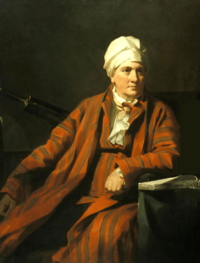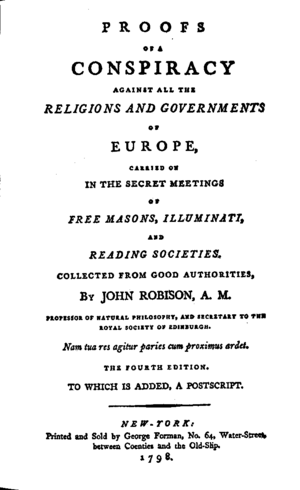John Robison (physicist) facts for kids
Quick facts for kids
John Robison
|
|
|---|---|

Robison in 1798
|
|
| Born | 4 February 1739 Boghall, Baldernock, Stirlingshire, Scotland
|
| Died | 30 January 1805 (aged 65) |
| Alma mater | Glasgow University |
| Scientific career | |
| Fields | Physics, Mathematics, Chemistry |
| Institutions | Glasgow University, Edinburgh University |
| Notes | |
|
Residential Member of the Edinburgh Philosophical Society
Fellow of the Royal Society of Edinburgh (1783) Member of the Glasgow Literary Society |
|
John Robison (born February 4, 1739 – died January 30, 1805) was a smart British scientist. He was a professor of natural philosophy at the University of Edinburgh. Natural philosophy was an old name for what we now call science, especially physics.
John Robison was an important member of the Royal Society of Edinburgh. He helped start this group and was its first general secretary. He also invented the siren, which is a device that makes a loud noise. He even worked with the famous inventor James Watt on an early steam car.
Later in his life, after the French Revolution, Robison wrote a book called Proofs of a Conspiracy in 1797. In this book, he claimed that a secret group called the Illuminati had secretly joined the Freemasons. He believed they were trying to change governments and religions. His son, Sir John Robison, also became a famous inventor.
Contents
John Robison's Life Story
John Robison was born in Boghall, Scotland. His father was a merchant in Glasgow. John went to Glasgow Grammar School and then to the University of Glasgow.
In 1758, he went to London for a short time. After that, he became a tutor for the son of Sir Charles Knowles, who was an admiral in the navy. Robison sailed with the Royal Navy on important trips, including one to Quebec and another to Portugal. He used his great math skills to help with navigation and surveying (mapping land).
When he came back to Britain in 1762, he joined the Board of Longitude. This was a group of scientists who tested a special clock called a marine chronometer. This clock helped sailors find their exact location at sea.
Later, Robison lived in Glasgow. He worked with other famous scientists like James Watt and Joseph Black. In 1766, he became a Professor of Chemistry at the University of Glasgow.
In 1770, he traveled to Russia. He worked as a secretary for Admiral Charles Knowles again. While there, he taught mathematics to young cadets at the Russian Naval Academy. He even got a high rank, like a lieutenant colonel!
Robison returned to Scotland in 1773. He became a Professor of natural philosophy at the University of Edinburgh. He taught about many different science topics, including mechanics (how things move), hydrostatics (how liquids behave), astronomy (space), optics (light), electricity, and magnetism. His ideas about how machines work were very important for science in the 1800s.
In 1783, he became the General Secretary of the Royal Society of Edinburgh. He also wrote many articles for the Encyclopædia Britannica in 1797. These articles explained the science, math, and technology of his time. He also helped publish the science lectures of his friend, Joseph Black.
Robison worked with James Watt on an early steam car. This project didn't go anywhere, but it shows how interested Robison was in new inventions. He also invented the siren. Another scientist, Charles Cagniard de la Tour, later improved it and gave it its name.
About Proofs of a Conspiracy
Near the end of his life, in 1797, John Robison published his famous book, Proofs of a Conspiracy. The full title was Proofs of a Conspiracy against all the Religions and Governments of Europe, carried on in the secret meetings of Freemasons, Illuminati and Reading Societies.
In this book, Robison claimed that secret groups like the Illuminati and Freemasons were secretly working together. He believed they were trying to change all the religions and governments in Europe. A monk named Alexander Horn gave Robison some of the information for his claims. Another French priest, Augustin Barruel, also had similar ideas. He believed the Illuminati had secretly joined the Freemasons, which he thought led to the big changes during the French Revolution.
John Robison's Books
- Outlines of Mechanical philosophy: Containing the Heads of a Course of Lectures, Edinburgh, 1781.
- Outlines of a Course of Experimental Philosophy, Edinburgh, 1784.
- Outlines of a Course of Lectures on Mechanical Philosophy, Edinburgh, 1803.
- Elements of Mechanical Philosophy: Being the Substance of a Course of Lectures on that Science, Edinburgh, 1804.
- Robison wrote over forty articles for the third edition of the Encyclopædia Britannica (1797). Some of these articles included: Resistance of Fluids, Roof, Running of Rivers, Seamanship, Telescope and Water-works.
- A System of Mechanical Philosophy, 1804.
- Proofs of a Conspiracy against all the Religions and Governments of Europe, carried on in the Secret Meetings of Free-Masons, Illuminati and Reading Societies, etc., collected from good authorities, Edinburgh, 1797. This book has been reprinted many times.
See also
- Augustin Barruel, another writer who believed in similar conspiracies.
- Lorenzo Hervás, who wrote about the causes of the French Revolution.
- Nicholas Bonneville
- Honoré Gabriel Riqueti, comte de Mirabeau
Sources
- Past anti-Masons : John Robison, on masonicinfo.com
- Biography, Papers of John Robison, Edinburgh University Library
- "The French Revolution and the Bavarian Illuminati", on Robison and Barruel, Freemasonry BC-Y
- "Memoirs of the Life of Dr. Robison," Philosophical Magazine, Vol. X, 1801.
- "Biographical Memoirs of Dr. Robinson, of Edinburgh," Philosophical Magazine, Vol. XIII, 1802.


